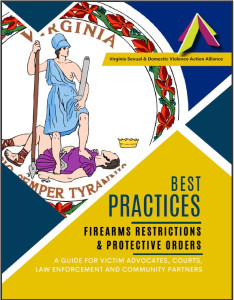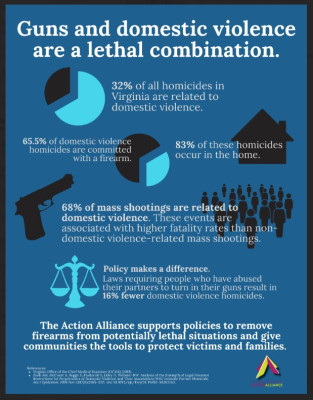Resources Library: Homicide & Lethality Assessment
Start a Search:
Family and Intimate Partner Homicide: 2011
The Office of the Cheif Medical Examiner released it's annual report from the Family and Intimate Partner Homicide Surveillance Project in April, 2013. The annual report is a descriptive analysis of the characteristics and circumstances surrounding family and intimate partner homicide in Virginia in 2011. This and other reports from the Family and Intimate Partner Homicide Surveillance Project can be found here.
Firearms Restrictions and Protective Orders in Virginia

Recent changes in Virginia code pertaining to firearms, firearm restrictions, surrender of firearms, and new Substantial Risk Orders can substantially impact the lives and safety of survivors of intimate partner violence. To assist survivors in making decisions regarding petitioning for protective orders and with safety planning, it is essential that advocates are knowledgeable about both the legal remedies as they pertain to firearms and the processes and procedures in their communities for implementation of these new remedies.
The Virginia Domestic Violence and Firearms Workgroup worked with local, state, and national partners to create new resources to support implementation of firearms restrictions in communities across Virginia. The toolkit is intended to serve as a foundational resource for sexual and domestic violence advocates – in their work with survivors and communities – to maximize safety and to ensure compliance with Virginia law.
For more information on how to best use these tools and/or for technical assistance and training to support implementation in your community, please contact the Virginia Sexual & Domestic Violence Action Alliance at training@vsdvalliance.org.
To download this resource, click here.
Guns and Domestic Violence are a lethal combination - Infographic

The Action Alliance supports policies to remove firearms from potentially lethal situations and give law enforcement officers, prosecutors, and courts tools to effectively enforce measures to protect victims, their families, and the broader community. This infographic highlights some of the ways that firearm-based violence and domestic violence intersect featuring statistical data from multiple resources.
Homicide-Suicide in Virginia 2006-2010: Who is at risk?

The Office of the Cheif Medical Examiner released a new report in June, 2013, titled Homicide-Suicide in Virginia 2006-2010: Who is at risk? This report utilizes 2006 to 2010 data from the Family and Intimate Partner Homicide Surveillance Project to answer these questions: who is most at risk for domestic violence related homicide-suicide; and, what relationship characteristics create the most danger for homicide-suicide? This and other reports from the Family and Intimate Partner Homicide Surveillance Project can be found here.
New Reports from the Virginia Violence Death Reporting System
The Office of the Chief Medical Examiner in the Virginia Department of Health has issued two new reports from the Virginia Violent Death Reporting System: Homicide Across the Life Course and Homelessness and Violent Death.
Homicide Across the Life Course examines homicides from two viewpoints. First, a longitudinal perspective describes changing homicide rates from 2003-2011. Second, a life course perspective examines how homicide looks for different age groups and how homicide risk changes as we age. This report identifies populations who are more at risk than others, and documents regions of Virginia and circumstances surrounding homicide that can assist in developing targeted responses and interventions to reduce homicide and support healthier communities in the Commonwealth.
Homelessness and Violent Death examines violent death, particularly homicides and suicides, among people who were homeless at the time of death. Violence prevention is a challenge for any population, but it may be especially so for homeless persons whose daily life and poor access to fundamental resources such as housing, safety, food, and health care creates the opportunity and conditions for violence. Their vulnerable status is exacerbated by substance abuse problems and mental health conditions, which may not be addressed in any meaningful way because they are homeless.

